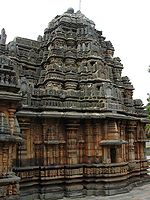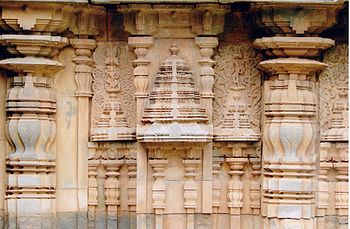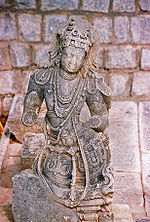
Siddhesvara Temple
Encyclopedia


Haveri
Haveriis a town in Karnataka. It is the administrative headquarters of Haveri District. The name Haveri is derived from the Kannada words havu and keri, which means place of snakes. Haveri is famous for its cardamom garlands. It is said that Haveri had around 1000 maths in ancient days. One of...
in Haveri district
Haveri District
Haveri is a district in the state of Karnataka, India with the potential to become a tourist hub. As of 2001, it had a population of 1,439,116 of which 20.78% were urban residents.-Tourism:Examples of tourist attractions in the district:...
, Karnataka
Karnataka
Karnataka , the land of the Kannadigas, is a state in South West India. It was created on 1 November 1956, with the passing of the States Reorganisation Act and this day is annually celebrated as Karnataka Rajyotsava...
state, India. It is considered an ornate example of 12th century Western Chalukyan art
Western Chalukya architecture
Western Chalukya architecture , also known as Kalyani Chalukya or Later Chalukya architecture, is the distinctive style of ornamented architecture that evolved during the rule of the Western Chalukya Empire in the Tungabhadra region of central Karnataka, India, during the 11th and 12th centuries...
and is well-known for the many loose sculptures of Hindu deities that exist in it, and is the finest testimonial for Vishwakarma sthapathis in sculting this temple. However, inscriptional
Epigraphy
Epigraphy Epigraphy Epigraphy (from the , literally "on-writing", is the study of inscriptions or epigraphs as writing; that is, the science of identifying the graphemes and of classifying their use as to cultural context and date, elucidating their meaning and assessing what conclusions can be...
evidence would suggest that the initial consecration of the temple was in late 11th century. An interesting aspect about the temple is that it faces west, instead of facing the rising sun in the east–a standard in Chalukyan constructions. Though it is currently used as a Shaiva temple dedicated to God Shiva
Shiva
Shiva is a major Hindu deity, and is the destroyer god or transformer among the Trimurti, the Hindu Trinity of the primary aspects of the divine. God Shiva is a yogi who has notice of everything that happens in the world and is the main aspect of life. Yet one with great power lives a life of a...
, historians are unsure by which faith or sect the temple was originally consecrated and to which deity. This uncertainty perhaps stems from the many loose sculptures of deities that exist and the degradation of primary wall images.
Temple plan

Soapstone
Soapstone is a metamorphic rock, a talc-schist. It is largely composed of the mineral talc and is thus rich in magnesium. It is produced by dynamothermal metamorphism and metasomatism, which occurs in the areas where tectonic plates are subducted, changing rocks by heat and pressure, with influx...
, is located at the east end of the town. From inscriptions, Haveri was originally called Nalapuri and was one of the oldest agraharas (place of learning) in modern Karnataka. An inscription dated 1067 CE in the town mentions the grant of the village to 400 Brahmin
Brahmin
Brahmin Brahman, Brahma and Brahmin.Brahman, Brahmin and Brahma have different meanings. Brahman refers to the Supreme Self...
s. The temple bears close resemblance to a few other Chalukyan temples in the vicinity of Haveri; the Muktesvara temple at Chavudayyadanapura, the Somesvara temple at Haralhalli and the Siddharamesvara temple at Niralgi. The entire basement of this temple has sunk by a few feet, making it necessary to descend into the open mantapa (hall).

Surya
Surya Suraya or Phra Athit is the chief solar deity in Hinduism, one of the Adityas, son of Kasyapa and one of his wives, Aditi; of Indra; or of Dyaus Pitar . The term Surya also refers to the Sun, in general. Surya has hair and arms of gold...
exists below the little Kirthimukha
Kirthimukha
Kirtimukha is the name of a swallowing fierce monster face with huge fangs, and gaping mouth, quite common in the iconography of Indian and Southeast Asian temple architecture...
s (gargoyle faces) on the eastern wall (back wall) of the temple, though, an image of Shiva, sculpted out of an independent slab of stone and mounted in front of the Sikhara
Sikhara
Śikhara, a Sanskrit word translating literally to "mountain peak", refers to the rising tower in the Hindu temple architecture of North India. Sikhara over the sanctum sanctorum where the presiding deity is enshrined is the most prominent and visible part of a Hindu temple of North India.In south...
(superstructure) above the mantapa roof, would suggest otherwise. Overall, the temple plan bears all the hallmarks of a standard 11th century Chalukyan construction with dravida
Dravidian architecture
Dravidian architecture was a style of architecture that emerged thousands of years ago in Southern part of the Indian subcontinent or South India. They consist primarily of pyramid shaped temples called Koils which are dependent on intricate carved stone in order to create a step design consisting...
architectural articulation
Articulation (architecture)
Articulation, in art and architecture, is a method of styling the joints in the formal elements of architectural design. Through degrees of articulation, each part is united with the whole work by means of a joint in such a way that the joined parts are put together in styles ranging from...
to which some innovative 12th century elements such as aedicules, miniature decorative towers on pilaster
Pilaster
A pilaster is a slightly-projecting column built into or applied to the face of a wall. Most commonly flattened or rectangular in form, pilasters can also take a half-round form or the shape of any type of column, including tortile....
s, were added.
Sculptures


Parvati
Parvati is a Hindu goddess. Parvati is Shakti, the wife of Shiva and the gentle aspect of Mahadevi, the Great Goddess...
), Vishnu and his consort Lakshmi, the Sun God Surya
Surya
Surya Suraya or Phra Athit is the chief solar deity in Hinduism, one of the Adityas, son of Kasyapa and one of his wives, Aditi; of Indra; or of Dyaus Pitar . The term Surya also refers to the Sun, in general. Surya has hair and arms of gold...
, Nāga
Naga
Naga or NAGA may refer to:* Nāga, a group of serpent deities in Hindu and Buddhist mythology.-People:* Nayan / Nayar/Nair people of Kerala Society* Naga people, a diverse ethnic identity in Northeast India...
-Nagini
Nagini
Nagini may refer to:*Nāginī, female counterpart for a class of entity or being that takes the form of a very large snake*Nagini , a character, who is a snake, in the Harry Potter series...
(the male and female snake goddess), Ganapati and Kartikeya, the sons of Shiva. Shiva is depicted with four arms, holding his attributes: the damaru (drum), the aksamala (chain of beads) and the trishul (trident) in three arms. His lower left arm rests on Uma, who is seated on Shiva's lap, embracing him with her right arm while gazing into his face. The sculpture of Uma is well decorated with garlands, large earrings and curly hair. The Naga and Nagini, with their tails intertwined, appear on the side of the door to the vestibule (antechamber) along with an image of Parvati
Parvati
Parvati is a Hindu goddess. Parvati is Shakti, the wife of Shiva and the gentle aspect of Mahadevi, the Great Goddess...
. A niche depicts a curious male figure with six hands, the two lower hands each hold a linga (the symbol of Shiva) and the middle left hand holds a chakra
Chakra
Chakra is a concept originating in Hindu texts, featured in tantric and yogic traditions of Hinduism and Buddhism. Its name derives from the Sanskrit word for "wheel" or "turning" .Chakra is a concept referring to wheel-like vortices...
(wheel).
The architrave above the vestibule entrance bears images of Brahma
Brahma
Brahma is the Hindu god of creation and one of the Trimurti, the others being Vishnu and Shiva. According to the Brahma Purana, he is the father of Mānu, and from Mānu all human beings are descended. In the Ramayana and the...
, Shiva
Shiva
Shiva is a major Hindu deity, and is the destroyer god or transformer among the Trimurti, the Hindu Trinity of the primary aspects of the divine. God Shiva is a yogi who has notice of everything that happens in the world and is the main aspect of life. Yet one with great power lives a life of a...
and Vishnu
Vishnu
Vishnu is the Supreme god in the Vaishnavite tradition of Hinduism. Smarta followers of Adi Shankara, among others, venerate Vishnu as one of the five primary forms of God....
, with Shiva in the centre. Ganapati and Kartikeya flank Brahma and Vishnu. On either side of the doorway is a perforated stone worked window, and the main shrine (garbhagriha
Garbhagriha
Garbhagriha or Garbha griha is the small unlit shrine of a Hindu temple.Garbhagriha or ' is a Sanskrit word meaning the interior of the sanctum sanctorum, the innermost sanctum of a Hindu temple where resides the murti of the primary deity of the temple...
or cella) has a plain linga (the symbol of Shiva). Some ceiling panels contain images of the saptamatrika ("seven mothers") while a square column contains images of the ashtadikpalas ("eight guardians") along with the Hindu trimurthy ("three forms") and Surya. The saptamatrikas are also carved into the wall of a step well outside. The saptamatrika sculptures on frieze
Frieze
thumb|267px|Frieze of the [[Tower of the Winds]], AthensIn architecture the frieze is the wide central section part of an entablature and may be plain in the Ionic or Doric order, or decorated with bas-reliefs. Even when neither columns nor pilasters are expressed, on an astylar wall it lies upon...
s has the female deities, generally each with a child on the lap to denote motherhood and are identified by the vahana
Vahana
Vāhana denotes the being, typically an animal or mythical entity, a particular deva is said to use as a vehicle. In this capacity, the vāhana is often called the deity's mount. Upon the partnership between the deva and his vāhana is woven much iconography and mythology...
(vehicle) of their male counterpart, found under them. At one end of the frieze is Shiva and at the other is Ganapati. Next to Shiva are the Matrika ("mother") goddessses: Brahmi (or Brahmani), Brahma's consort, with a goose; Maheshvari, the consort of Shiva has a Nandi (bull); Vaishnavi, the consort of Vishnu has a Garuda
Garuda
The Garuda is a large mythical bird or bird-like creature that appears in both Hindu and Buddhist mythology.From an Indian perspective, Garuda is the Hindu name for the constellation Aquila and...
(eagle); Kaumari, the consort of Kartikeya has a peacock; Varahi, the consort of Varaha
Varaha
Varaha is the third Avatar of the Hindu Godhead Vishnu, in the form of a Boar. He appeared in order to defeat Hiranyaksha, a demon who had taken the Earth and carried it to the bottom of what is described as the cosmic ocean in the story. The battle between Varaha and Hiranyaksha is believed to...
, has a buffalo (instead of a boar); Indrani, the consort of Indra, has an elephant; and the last "mother" could be a skeletal image of Chamunda
Chamunda
Chamunda , also known as Chamundi, Chamundeshwari and Charchika, is a fearsome aspect of Devi, the Hindu Divine Mother and one of the seven Matrikas . She is also one of the chief Yoginis, a group of sixty-four or eighty-one Tantric goddesses, who are attendants of the warrior goddess Durga...
with a dog or could be a dead body. Other loose sculptures in niches worthy of mention are those of Surya canopied by a seven hooded snake, and the Mahishasuramardini (a form of Durga). Within the temple premises are several old-Kannada inscriptions recording grants, the earliest of which is inscribed on a beam inside the temple and is dated to 1087 CE while another stone inscription (shilashasana) dated to 1108 CE stands outside.

